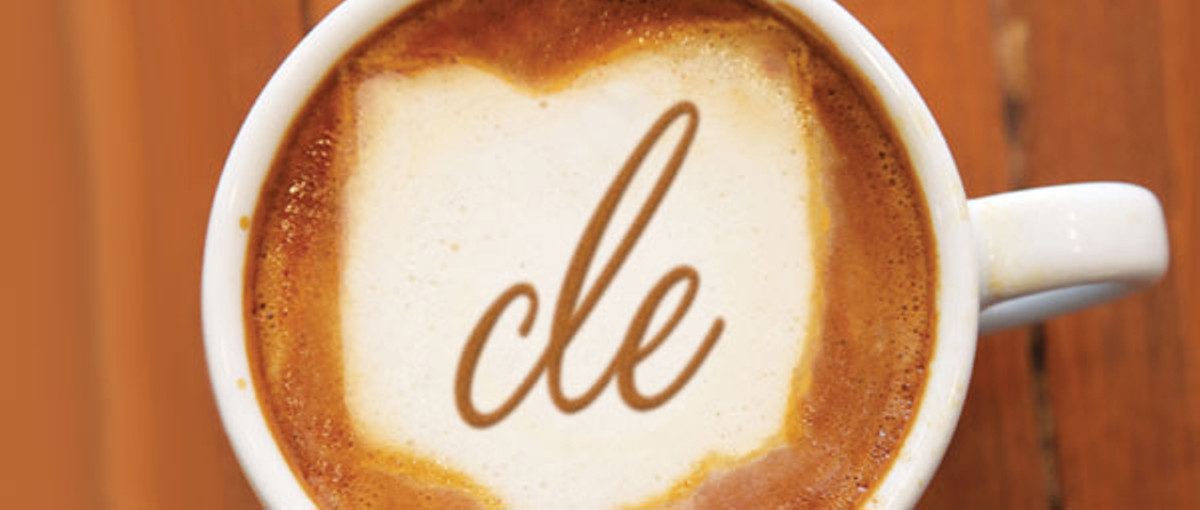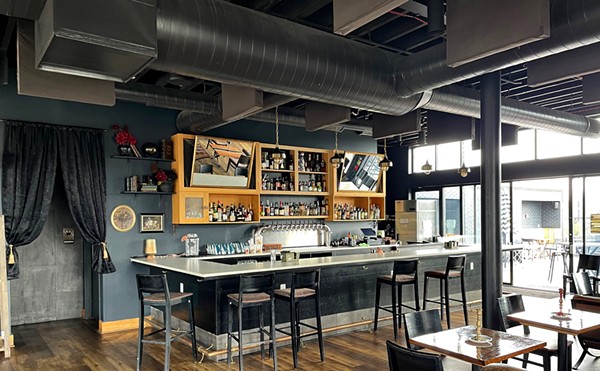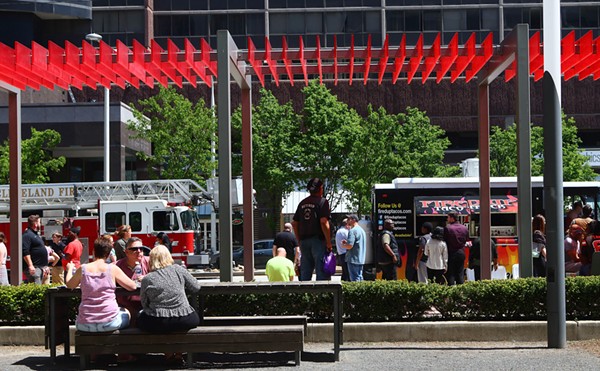Walk into Pour Cleveland for the first time and you might bump into a group of people standing around a large communal table, each slurping coffee from a deep spoon with alarming gusto. Across town, in a hulking brick warehouse on Cleveland's near-west side, a mop-topped man stands in front of a gleaming steel roaster, its tumbling drum filled with still-green coffee beans.
In Tremont, an obsessive barista spends the first 30 minutes of his day dialing in an espresso machine, tweaking the variables in a quest for the ever-elusive "god shot," that pitch-perfect cup.
While it might not be obvious to the casual observer, Cleveland is on the cusp of becoming a Great Coffee Town, a place where finding a top-quality cup of java is as easy as reaching for a world-class IPA. Some insiders say that we're already there, while others believe we still have a way to go. But pretty much everybody who follows the local coffee scene agrees that we're heading in the right direction and bound for glory.
It wasn't that a guy couldn't wrap his mittens around a decent cup of joe before today. Cleveland has been blessed with homegrown shops devoted to sourcing and serving the best coffee available at the time. In fact, local outfits like Arabica, Phoenix, City Roast and Loop actually were ahead of the curve, setting up their own small-batch roasting operations to maximize freshness and flavor.
But like any revolution — and coffee, indeed, is in the midst of a revolution — the past and its players often get left in the dust as the new guard steps in, takes over, and charts a new course. That course took its sharpest turn in 2012, when Kim Jenkins opened Rising Star Coffee Roasters in the Ohio City firehouse building. The movement picked up steam a little more than a year later when Charlie Eisenstat opened Pour downtown. More and more, they're being joined by a supporting cast of new cafes and small-batch roasters as Cleveland's coffee counter culture continues to pick up steam.
Eisenstat already had a finance degree and two law degrees when he decided to go back to school. In 2011, the Northeast Ohio native took a weeklong sabbatical from his job at a Cleveland law firm to attend the American Barista & Coffee School in Portland, where he immersed himself in topics like Grinding, Tamping and Extracting Espresso, Steaming and Foaming Milk for Lattes and Cappuccinos, and the Principles of Latte Art. Two years later, at the tail end of 2013, he opened Pour Cleveland, downtown's premier coffee shop.
"Experiencing Portland's coffee culture is what really mailed it home for me," says Eisenstat, seated at the coffee bar within arm's reach of his pricey espresso machine. "Cleveland, especially now, is such a similar city to Portland in terms of food, beer, cocktails ... I saw the potential for what it could be."
Cities with great food and drink cultures don't always become great coffee cities, but almost every great coffee city began with a robust food and drink scene. For a city like Cleveland, with its thriving independent restaurant community, emerging craft cocktail culture, and flourishing beer brewing trade, the emergence of a budding coffee culture seemed as inevitable as a Sunday hangover.
"That's what pushed me to go all in and leave my regular job and do this fulltime," notes Eisenstat. "Cleveland already had an amazing culinary scene with world-class chefs opening some amazing restaurants. We've got a great beer and microbrewery scene for the size city we are. I just thought we were a little behind as far as a culinary approach to coffee. I wish I did this five years ago to get people accustomed to it earlier."
You can't talk about the trajectory of coffee in this country without discussing waves. Americans have been riding coffee waves for 150 years, ever since caffeine-delivery vehicles like Folgers and Maxwell House made waking up a whole lot more bearable for countless moms and dads. A mounting aversion to those poor quality, mass produced commodities gave rise to the "second wave" in American coffee, when break-out brands like Peet's and Starbucks convinced coffee drinkers to trade in their Mr. Coffee machines for a tall, half-caff soy latte with a caramel drizzle. While those brands did more to advance the coffee culture in this country than anything, the focus at those mega-chains long ago shifted away from quality and toward cost, efficiency and profit.
Which brings us to the Third Wave, when ground-breaking shops like Intelligentsia in Chicago, Counter Culture in North Carolina, and Stumptown in Portland began shaping business plans around the noble quest to preserve, highlight and present the innate flavors of the globe's highest quality coffee beans. In cities like Portland, Seattle, San Francisco, Chicago and New York, true coffee nerds began cultivating relationships with small farmers in places like South America, Central America, Africa and Indonesia to seek out unique flavor profiles previously unavailable.
Third Wave coffee shops often can be characterized more by what they don't serve than what they do. In place of batch-brewed, heavily roasted blends kept warm until they're sold, artisanal shops grind and brew meticulously sourced and freshly roasted beans by the cup to order. Gone are sprawling multi-panel menus littered with countless concoctions and sizes, replaced by fewer options and smaller serving sizes.
"The easiest way to understand what Third Wave roasters and coffee shops are trying to do is to highlight the terroir so that all the unique choices the farmer made and the choices the producer made and the choices the roaster made that have left their imprint on that roasted seed you're drinking are actually reflected in the cup," explains John Johnson, partner and quality control manager at Rising Star, which recently moved and expanded its roasting operations into the Hildebrandt Building on the near-west side.
Customers who order a cup of java at Pour in the 5th Street Arcades will observe a barista carefully weigh and grind a precise measure of freshly roasted coffee beans. After pre-wetting the filter, the grounds will be placed in a simple funnel-shaped device that sits atop a receiving vessel. Over the course of three minutes, the barista will anoint the grounds with a slow, steady stream of 200-degree water until the resulting yield of coffee reaches around 350 grams, at which point it's poured into a pre-warmed ceramic mug.
While the typical iced coffee is simply chilled hot-brewed coffee, Pour invested in beautiful and functional cold-brew systems that are prominently displayed along its back wall. The 4-foot-tall glass contraptions, which look like elaborate bongs, use ice water and time (about eight hours) to produce cold-brewed coffee with all of the body and none of the bite of its conventionally brewed sibling.
All the above machinations might seem obsessive — even affected — but they're science-based maneuvers designed to extract the bean's good qualities and exclude the bad, all while maintaining an exacting level of consistency. Ideally, if everything goes as planned, what's left in the cup is the true essence of the bean — all the aromas, flavors and acidity set free from an overbearing roast and bitterness. Sip an expertly brewed cup of Paseban from Ciluengsi, West Java, for example, and you'll discern hints of chocolate, red currant and raspberry. Like a fine wine, the end product is the result of a long chain of decisions that include where the bean is grown, how and when it's harvested, how it's processed, how and when it was roasted and, lastly, how it is brewed.
But to outsiders, the whole process can appear foreign, idiosyncratic and slightly overwhelming, admits owner Eisenstat.
"We have people who come in and hover seven feet from the counter because it looks intimidating," he explains. "I've seen people turn around and walk right out the door and probably head to Starbucks."
But the best Third Wavers are teachers, advocates of the culture, who look for any and all occasions to spread the gospel of the good bean. To Eisenstat and those like him, there is comfort in the process. Comfort and opportunity.
"We brought the process front and center by design," he says. "The pour-over process isn't necessarily better, but it helps people with the transition because there's time to have a conversation. They see you doing something that looks like a science experiment, they start asking questions, which gives you an opportunity to educate them."
One of the people on the receiving end of that informal tutoring is Dan Cihon, a regular fixture at Pour. Working downtown, the Mentor resident hits up the attractive white-tiled storefront at least two or three times per week for his cup. Like many self-described "coffee snobs," Cihon's ascent to the world of Third Wave was gradual and one-directional.
"It started with tasting the difference between buying Starbucks beans and grinding and brewing them at home, compared to what you get in one of their coffee shops," he explains. "Then trying other brands of fresh-roasted beans. Then going to lighter roast coffees and tasting an even bigger difference. I can't go back now."
Living in Mentor meant that Cihon was buying his beans mail order, usually from Counter Culture, and grinding and brewing at home. A quick search of his favored supplier's retail outlets led him to Pour, which has since moved on from that brand. As a home-schooled coffee guy who relied on the Internet for the bulk of his brew tips, the budding coffee enthusiast was deeply observant of what his baristas were doing behind the bar.
"I was picking their brain about grind and water temperature," he says. "They're very open to people like me who are interested in making their own coffee at home. I've also witnessed them steer first-time customers in the right direction when it comes to picking a coffee."
For Cleveland to continue heading down the path to coffee enlightenment, say those involved, owners and baristas need to continue educating, converting and pushing customers much the same way the corner wine shop owner will nudge a neighbor away from white zinfandel and toward something more interesting. That includes maintaining a zero-tolerance policy against stereotypically snooty baristas who have no patience for unenlightened consumers.
Fortunately, that's a quality Midwest-raised Clevelanders typically excel at.
"What initially drew me to the Cleveland coffee scene was that it was approachable and friendly," says Johnson. "In places like San Francisco you might get the stereotypical tattooed smug baristas who don't want to give you the time of day."
Walk into some fanatical coffee shops in San Fran or L.A. and you won't find flavored syrups or sweeteners of any kind. While the baristas at joints like these are coming from a place of quality and authenticity — "You wouldn't put ketchup on a dry-aged Wagyu ribeye!" — the practice isn't exactly catnip to newbies.
Flavored syrups, creams and sweeteners are frowned upon not because the results aren't delicious, but because they negate all the purposeful craft-based decisions that have been made along the way.
"The reluctance to do flavored drinks or put cream in coffee doesn't come from a standpoint of 'Oh, that tastes gross,'" explains Johnson. "It comes from a desire to show the hard work that people have done, and you don't want that diluted. When you get a Frappuccino at Starbucks, the only choices you're tasting are those that Starbucks made when they decided who to buy their vanilla syrup from. The flavor of the coffee is completely gone."
Walk into either of Rising Star's shops in Ohio City or Little Italy and you won't find the ubiquitous line-up of flavored syrups, but you can still score a teaspoon of sugar. While Johnson understands the principle of purity, he knows that it's not wise or beneficial to implement it in a new market like Cleveland, where inclusion is the name of the game.
"I think it's wrong-headed when places don't even offer cream or sugar," he adds. "We have so many great customers who started off by putting cream and sugar in their coffee who now drink it black. It's baby steps. I wouldn't be a whiskey drinker if I hadn't started with Southern Comfort and Coke. There's an evolution to it."
Loop owner Dave Foran stocks a wide array of flavored syrups in his Tremont coffee shop. Yet he also roasts his own beans daily onsite, an activity much appreciated by his neighbors who wake each morning to the scent of gently toasting beans. He sidesteps pour-overs ("too slow") in favor of drip and perfectly pulled shots of espresso. That makes his shop a sort of hybrid between Second and Third Wave. Like most of his colleagues in Cleveland, he's broadminded and accommodating while attempting to advance the cause.
"We serve people what they want," Foran explains. "I don't want to be the pretentious coffee shop that tells you how to drink it. But we'll also try and encourage you to drink coffee in a way that we like, to open their eyes to the different flavor profiles you get from all over the world. We have to build the clientele, the people who start coming in for more than just a way to wake up in the morning and actually start enjoying it."
Some say that Cleveland is at a critical tipping point in its coffee evolution. Compared to many cities, we're light years ahead. Compared to others, even nearby Columbus, we're still playing catch up. That city to our south has more than double the number of top-quality coffee roasters and retail shops than we do, but they shouldn't get too comfortable, says Peter Brown.
"It's only been a short period of time, but we're catching up to other cities really quickly," asserts Brown, who recently relocated from Columbus to Cleveland to open Six Shooter Coffee, a small batch micro-roaster. "It's an exciting time to move to Cleveland and start doing things here."
Brown's first job was in a coffee shop, and he's barely left them since. In addition to his fresh-roasted beans, which can be found on the shelves of The Grocery OHC and in pints of Platform Beer Co.'s oatmeal and coffee stout, Brown is in the planning stages of opening a coffee shop. He selected Cleveland as its future home because he knows there will be a ready, willing and eager audience for his product.
"Clevelanders really care about quality, and I respect that," he says. "The Cleveland culinary and beer scenes are getting national attention, and that's a big indicator that Clevelanders care about quality."
Brown has worked in enough coffee shops to have a pretty solid grasp of what makes them succeed while propelling the local coffee culture in the right direction.
"Cafes have to be warm, friendly and inviting places," he says. "The baristas have to know that this a huge growing period both in Cleveland and America, and if they aren't patient and knowledgeable, then the education isn't going to happen. If they are, then I think we're really going to see this Third Wave grow and become a good thing."










